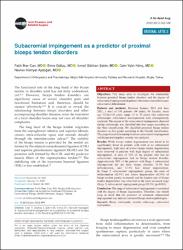Subacromial impingement as a predictor of proximal biceps tendon disorders

View/
Date
2022Author
Can, Fatih İlkerGültaç, Emre
Şahin, İsmail Gökhan
Kılınç, Cem Yalın
Aydoğan, Nevres Hürriyet
Metadata
Show full item recordCitation
CAN Fatih İlker,GÜLTAÇ Emre,ŞAHİN İsmail Gökhan,KILINÇ Cem Yalın,AYDOĞAN Nevres Hürriyet Subacromial impingement as a predictor of proximal biceps tendon disorders. Joint diseases and related surgery, vol.33, no.1, 2022, ss.142 - 148. Doi: 10.52312/jdrs.2022.499Abstract
Objectives: This study aims to investigate the relationship between proximal biceps tendon disorders and the degree of subacromial impingement in patients who underwent arthroscopic subacromial debridement. Patients and methods: Between January 2015 and June 2021, a total of 110 patients (44 males, 66 females; mean age: 52.5±11.43 years; range, 15 to 78 years) who underwent arthroscopic subacromial decompression were retrospectively analyzed. The degree of the subacromial impingement observed during arthroscopy was classified into four stages according to the Neer classification. We classified proximal biceps tendon disorders as five grades according to the Nirschl classification. The proportional relationship between subacromial impingement and biceps tendinopathy severity was analyzed. Results: While biceps tendon degeneration was found to be significantly lower in patients with mild or no subacromial impingement, high rates of severe biceps tendon degeneration were observed in patients with high degree of subacromial impingement. A total of 75% of the patients who had no subacromial impingement had no biceps tendon disorder. Approximately 50% of the patients with Stage 1 subacromial impingement did not have biceps disorder, 31.3% had inflammation, and 12.5% had minor degeneration. In Stage 2 subacromial impingement group, the ratio of inflammation (42.9%) and minor degeneration (42.9%) of biceps tendon greatly increased, and the highest rate of biceps tendon degeneration was observed in the most advanced stage (Stage 3) subacromial impingement group (39.3%) (p=0.001). Conclusion: The stage of subacromial impingement is correlated with the degree of biceps degeneration. Therefore, one should keep in mind that the presence of advanced subacromial impingement may indicate advanced biceps tendon pathologies.

















